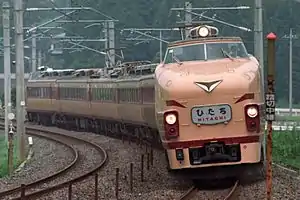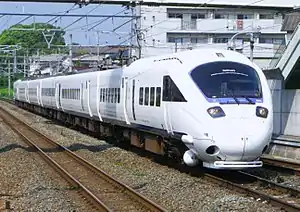103 series
The 103 series (103系, 103-kei) is a DC electric multiple unit (EMU) commuter train type introduced in 1963[2] by Japanese National Railways (JNR), and currently operated by West Japan Railway Company (JR West) and Kyushu Railway Company (JR Kyushu). They were also operated by East Japan Railway Company (JR East) and Central Japan Railway Company (JR Central).
| 103 series | |
|---|---|
 JR West 103 series trains in various liveries at Suita Depot in October 2016 | |
| Manufacturer | Hitachi, Kawasaki Heavy Industries, Kinki Sharyo, Kisha Seizo, Nippon Sharyo, Teikoku Sharyo, Tokyu Car Corporation |
| Replaced | 101 series, KiHa 35, KiHa 37, KiHa 40, KiHa 47, KiHa 58 |
| Constructed | 1963–1984 |
| Entered service | December 1963 |
| Refurbished | 1996–2005 (for selected trains) |
| Scrapped | 1986– |
| Number built | 3,447 vehicles |
| Number in service | 63 vehicles (as of 2019)[1] |
| Number preserved | 7 vehicles |
| Number scrapped | 3,311 vehicles |
| Successor | 201 series, 203 series, 205 series, 209 series, 223 series, 225 series, 227 series, E231 series, 305 series, 313 series, 323 series |
| Formation | 2/3/4/5/6/7/8/10 cars per trainset |
| Operator(s) |
|
| Depot(s) | Hineno Morinomiya Nara Aboshi Hiroshima Karatsu Depok |
| Line(s) served | Various |
| Specifications | |
| Car body construction | Steel |
| Car length | 20,000 mm (65 ft 7 in) |
| Width | 2,800 mm (9 ft 2 in) |
| Height | 3,935 mm (12 ft 10.9 in) |
| Doors | 4 pairs per side |
| Maximum speed | 100 km/h (62 mph) |
| Traction system | Resistor control |
| Power output | 440 kW per car with motors |
| Acceleration | 2.0 km/h/s |
| Deceleration | 5.0 km/h/s |
| Electric system(s) | 1,500 V DC |
| Current collection method | overhead catenary |
| Bogies | DT33, TR201, TR212, TR64 or DT21T (103-3000 series and converted from 101 series ) |
| Braking system(s) | Dynamic brake, Electro-pneumatic brake, Hand brake |
| Safety system(s) | ATS-B, ATS-P, ATS-SK, ATS-SW, ATC-3, ATC-4, ATC-6, ATC-9 |
| Track gauge | 1,067 mm (3 ft 6 in) |
Some former JR East sets were also sold to Indonesia, where they operated on the KRL Jabodetabek system in Jakarta between 2004 and 2016.
Operations
JR East

JR East has operated previously a large number of 103 series sets on the following lines.
- Chūō Line (Rapid) (1973~83; and then also used in the Diamond anniversary (75th anniversary) celebration of the Mitaka Station on June 2005)
- Chūō-Sōbu Line (1979~2001; 1971~2003 for Tokyo Metro Tozai Line through-running services)
- Hachikō Line (1996–2005)
- Jōban Line (1971~86 for Chiyoda Line through-running services; 1967–2006 for Joban Line Rapid and Narita-Abiko Line through service)
- Kawagoe Line (1985–2005)
- Keihin-Tōhoku Line (1965–1998)
- Keiyō Line (1986–2005)
- Musashino Line (1980–2005)
- Nambu Line (1982–2004)
- Ōme Line (1976–2002)
- Akabane Line (now Saikyo Line) (1978–1990)
- Senseki Line (1979–2004; 2006~09)
- Tsurumi Line (1990–2005)
- Yamanote Line (1963~88)
- Yokohama Line (1972~89)
One four-car 103 series set has remained in use by JR East on the Senseki Line in the Sendai area between November 2006~21 October 2009.[3]
JR Central
JR Central has formerly used 103 series sets on Chuo Main Line services in the Nagoya area, but these were subsequently replaced by 211 series and 313 series trains.
JR-West

JR-West continues to operate a large number of 103 series sets, many of which have received extensive life-extension refurbishment.[4] JR-West currently operates 103 series sets on the following lines. They were also used on the Osaka Loop Line until October 2017. As of 2018, there are 99 cars still available in service.
Previous Operations (JR West):
- Akō Line
- Kabe Line (1992–March 2011)
- Kure Line (1992–March 15,2015)
- Osaka Loop Line (1969–October 2017)
- Sakurajima Line (1969–October 2017)
- Yamatoji Line (1969–January 25,2018)
- Wakayama Line (1970–January 2018)
- Osaka Higashi Line (1969–January 25,2018)
- Hanwa Line (1968–March 16,2018)
JR Kyushu
JR Kyushu operates a fleet of 103-1500 series sets on JR Chikuhi Line inter-running services.[4] As of 2018, there are 6 3-car trainsets still remain in service.
- Chikuhi Line (1982–present)
Overseas operations
Four former JR East 103 series 4-car units (Musashino Line sets KeYo 20, 21, 22, and 27) were shipped to Indonesia in 2004 to operate on the KRL Jabodetabek system in Jakarta.[5]
- KuMoHa 103: 105, 153
- MoHa 103: 654, 752
- MoHa 102: 231, 321, 810, 2009
- KuHa 103: 359, 384, 597, 632, 815, 822
- SaHa 103: 210, 246
These cars retain their Japanese numbering.
As of November 2016, all 103 series have been withdrawn.
 Former JR East 103 series EMU working in the Jakarta area of Indonesia, July 2007
Former JR East 103 series EMU working in the Jakarta area of Indonesia, July 2007 Former JR East set KeYo 21 in revised "JR Central" livery in Jakarta, December 2011
Former JR East set KeYo 21 in revised "JR Central" livery in Jakarta, December 2011 KeYo E20 with latest livery
KeYo E20 with latest livery
103-0 series
| 103-0 series | |
|---|---|
 JR West 103 series Osaka Loop Line, KuHa 103-1, January 2007 | |
| In service | 1963–present |
| Manufacturer | Hitachi, Kawasaki Heavy Industries, Kinki Sharyo, Kisha Seizo, Nippon Sharyo, Teikoku Sharyo, Tokyu Car Corporation |
| Replaced | 101 series, KiHa 35 |
| Constructed | 1963–1981 |
| Entered service | December 1963 |
| Refurbished | 1996–2005 (for selected trains) |
| Scrapped | 1986– |
| Number built | 3,198 vehicles |
| Number in service | 14 vehicles (as of 2019)[1] |
| Number preserved | 7 vehicles |
| Number scrapped | 3,139 vehicles |
| Operator(s) |
|
| Depot(s) | Hineno Morinomiya Nara Aboshi Hiroshima Depok |
| Line(s) served | Chūō Line (Rapid), Chūō-Sōbu Line, Chuo Main Line, Jōban Line, Narita Line, Keihin-Tōhoku Line, Keiyō Line, Musashino Line, Nambu Line, Ōme Line, Saikyo Line, Senseki Line, Tsurumi Line, Yamanote Line, Yokohama Line, Akō Line, Kabe Line, Kure Line, Osaka Loop Line, Sakurajima Line, Yamatoji Line, Wakayama Line, Osaka Higashi Line, Hanwa Line, Sanyō Main Line, Sakurai Line, Nara Line, Wadamisaki Line, Jakarta Kota-Bogor Line, Jatinegara-Bogor Line |
| Specifications | |
| Car body construction | Steel |
| Car length | 20,000 mm (65 ft 7 in) |
| Width | 2,800 mm (9 ft 2 in) |
| Height | 3,935 mm (12 ft 10.9 in) |
| Doors | 4 pairs per side |
| Maximum speed | 100 km/h (62 mph) |
| Traction system | Resistor control, Thyristor Chopper, DDM-VVVF, IGBT-VVVF (test run only) |
| Power output | 440 kW per car with motors |
| Acceleration | 2.0 km/h/s |
| Deceleration | 5.0 km/h/s |
| Electric system(s) | 1,500 V DC |
| Current collection method | overhead catenary |
| Bogies | DT33, TR201, TR212, TR64 |
| Braking system(s) | Dynamic brake, Electro-pneumatic brake, Hand brake |
| Safety system(s) | ATS-B, ATS-P, ATS-SK, ATS-SW, ATC-3, ATC-4, ATC-6, ATC-9 |
| Track gauge | 1,067 mm (3 ft 6 in) |
The 103-0 series trains were built between 1963 and 1981. Built for JNR as an "upgraded" version of the 101 series, the 103 series has been widely used around Japan and has been manufactured in a multitude of different body styles and configurations.
Based on the earlier 101 series, the 103 series has been used on various commuter services since 1963. In fact, some 103 series cars were actually converted from 101 series cars. The 103 series was the main rolling stock used on urban commuter services for a time.
Some sets have been used for at least 50 years, and their age is starting to show; as such, their use on various lines is diminishing and they are being replaced by newer trains. For instance, the 103 series are being replaced by the newer 323 series on the Osaka Loop Line where they famously operate.
The sets have been manufactured in a multitude of different body styles, with additional body styles being created over the years. Older sets had body styles similar to the one used on the 101 series.
Prototype
This 8-car unit was built in 1963 without air-conditioning. The cars were withdrawn from service between 1988 and 1991.
- Moha 103: 901-902
- Moha 102: 901-902
- Kuha 103: 901-904
Standard series
These were built between 1964 and 1970. While not originally fitted with air-conditioning, most of the cars were fitted with air conditioning from 1975. The bogies of the trailer cars were changed from TR201 to TR212 for the cars built from 1968. Cars fitted with TR212 bogies feature disc brakes, because they needed to run on higher speeds on the Jōban and Hanwa Lines.
- KuMoHa 103: 1-155
- MoHa 103: 1-278
- MoHa 102: 1-433
- KuHa 103: 1-177 & 501-638 (TR212 bogies fitted: 115-177 & 617-638)
- SaHa 103: 1-305 (TR212 bogies fitted: 226-305)
Air-conditioned prototype
This single 10-car unit was built in 1970. It was equipped with various air conditioning units and tested on the Yamanote Line in Tokyo. It was subsequently modified to become a standard air-conditioned set in 1978. In 2000, four cars were scrapped at the Narashino Depot; the remaining six cars were scrapped at Keiyō Rolling Stock Center in 2005.
- MoHa 103: 279-281
- MoHa 102: 434-436
- KuHa 103: 178-179
- SaHa 103: 306-307
Sets without air-conditioning
Built during 1972 and 1973, these units were similar to the air-conditioned prototype but without air-conditioning. This type was used mainly in Osaka area. Most cars were fitted with air-conditioning from 1976.
- MoHa 103: 282-330 & 364-374
- MoHa 102: 437-486 & 520-530
- KuHa 103: 180-212
- SaHa 103: 308-323
Air-conditioned sets
Built in 1973, they were similar to the air-conditioned prototype. They were fitted with motorized destination blinds on both sides.
- MoHa 103: 331-413 (excluding 364-374)
- MoHa 102: 487-569 (excluding 520-530)
- KuHa 103: 213-268
- SaHa 103: 324-359
ATC equipped sets
Built between 1974 and 1980. The front end design was changed with the driver's cab raised so that an ATC signalling system could be included. Kuha 103 of this version was used in the Tokyo area only.
- MoHa 103: 414-713
- MoHa 102: 570-869
- KuHa 103: 269-796 (excluding 500-700), 798, 809, 816
- SaHa 103: 360-471
Raised driver's cab
Built between 1979 and 1984. The front end design was the same as the ATC-equipped sets, although this type was not fitted with ATC. Kuha 103-811 & 816 were converted to include ATC in 1984.
- MoHa 103: 714-793
- MoHa 102: 870-2050 (excluding 900-2000)
- KuHa 103: 797, 799-850 (excluding 809, 816, 845, 847, 849)
- SaHa 103: 472-503
 Driver's cab of KuHa 103-235 car (without ATC), November 2008
Driver's cab of KuHa 103-235 car (without ATC), November 2008 JNR 103 & 205 series Yamanote Line meet at Uguisudani station, February 1986
JNR 103 & 205 series Yamanote Line meet at Uguisudani station, February 1986 Akabane Line KuHa 103-273 car with air-conditioning coupled with non air-conditioned middle cars, 1979
Akabane Line KuHa 103-273 car with air-conditioning coupled with non air-conditioned middle cars, 1979
 JR Kobe Line KuHa 103-184 car without air-conditioning, August 1983
JR Kobe Line KuHa 103-184 car without air-conditioning, August 1983 Yamanote Line air-conditioned prototype KuHa 103-178 car, October 1978
Yamanote Line air-conditioned prototype KuHa 103-178 car, October 1978 Yamanote Line ATC equipped KuHa 103-347 car, March 1985
Yamanote Line ATC equipped KuHa 103-347 car, March 1985 JR East Yokohama Line air-conditioned 103-0 series, circa 1988
JR East Yokohama Line air-conditioned 103-0 series, circa 1988 JR-West Yamatoji Line raised driver's cab KuHa 103-831 car, circa 1993
JR-West Yamatoji Line raised driver's cab KuHa 103-831 car, circa 1993 JR East Negishi Line air-conditioned 103-0 series, March 1998
JR East Negishi Line air-conditioned 103-0 series, March 1998 Two JR-West Fukuchiyama Line (left) and JR Kyoto Line air-conditioned 103-0 series, August 1999
Two JR-West Fukuchiyama Line (left) and JR Kyoto Line air-conditioned 103-0 series, August 1999 JR East MoHa 103-734 car in brown livery, August 1999
JR East MoHa 103-734 car in brown livery, August 1999 Jōban Line air-conditioned 103-0 series, January 2003
Jōban Line air-conditioned 103-0 series, January 2003 Musashino Line air-conditioned 103-0 series showing different driver's cab heights, August 2003
Musashino Line air-conditioned 103-0 series showing different driver's cab heights, August 2003 Tsurumi Line air-conditioned 103-0 series, June 2004
Tsurumi Line air-conditioned 103-0 series, June 2004 Osaka Loop Line air-conditioned KuHa 103-248 car, January 2005
Osaka Loop Line air-conditioned KuHa 103-248 car, January 2005 JR Central 103-0 series air-conditioned KuMoHa 103-18 car, April 2007
JR Central 103-0 series air-conditioned KuMoHa 103-18 car, April 2007 JR-West Hanwa Line 103-0 series air-conditioned car, April 2008
JR-West Hanwa Line 103-0 series air-conditioned car, April 2008.jpg.webp) JR West 103 series on Nara Line local service, April 2018
JR West 103 series on Nara Line local service, April 2018 JR West 103 series train Wadamisaki Line taken at Hyogo Station, March 2018
JR West 103 series train Wadamisaki Line taken at Hyogo Station, March 2018 JR-West San'yō Main Line air-conditioned 103-0 series set H19, May 2009
JR-West San'yō Main Line air-conditioned 103-0 series set H19, May 2009 KuHa 103-525 test car owned by Toshiba, March 2010
KuHa 103-525 test car owned by Toshiba, March 2010 JR-West Sakurajima Line raised driver's cab KuHa 103-823 car, March 2012
JR-West Sakurajima Line raised driver's cab KuHa 103-823 car, March 2012
Converted from 101 series
Some 101 series trailer cars were converted to the 103-0 series. The cars' bodies and bogies were 101 series originals as the conversions involved minimum modification. The last of these cars were withdrawn from service in 1999.
- SaHa 103: 751-780 (from SaHa 101)
- KuHa 103: 2001-2004 (from KuHa 100), 2051-2052 (from KuHa 101)
Experimental direct-drive mechanism (DDM-VVVF)
An insulated gate bipolar transistor traction system and direct-drive motors both manufactured by Toshiba were experimentally tested on car MoHa 103-502 (car #4) on ten-car set KeYo304 based on the Keiyō Line from May 2002; the car was originally manufactured in December 1975 by Nippon Sharyo. The direct-drive motors and IGBT inverters appear to be of the same specification as used on the experimental E993 series set due to similar cadences.
The use of direct-drive motors in the car gave the set a very unique sound, with both the roar of the old-fashioned resistor-controlled traction motors and the more modern, high-pitched cadence of the variable frequency drive in car MoHa 103-502; MoHa 103-502's use of direct-drive motors gave the car itself a very unique sound, as once the set reached a certain speed, the traction motors made no discernible noise.
The set entered service with the direct-drive motored car on 15 May 2003, but was retired and scrapped in December 2003 after just 7 months of service with this experimental car. Car MoHa 103-502 remains the last 103 series car to have been fitted with a variable frequency drive. As implied, the car no longer exists as it was scrapped in 2003; no JR train since (other than the E993 and E331 series sets) has used direct-drive motors in combination with IGBT or PMSM inverters.[6]
103-1000 series
| 103-1000 series | |
|---|---|
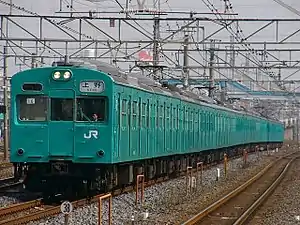 JR East 103-1000 series in emerald-green Jōban Line livery, April 2003 | |
| In service | 1970–1986 (Joban Line & Tokyo Metro Chiyoda Line local services) 1986–2004 (Joban Line Rapid Service) |
| Constructed | 1970–1971 |
| Entered service | 1970 |
| Scrapped | 2004 |
| Number built | 160 vehicles (16 sets) |
| Number in service | None |
| Number scrapped | 98 vehicles (103-1000 series, the rest of 62 vehicles were converted to 105 series) |
| Formation | 51–66 (JNR) |
| Operator(s) | JNR (1970-1987) JR East (1987-2004) |
| Line(s) served | Joban Line, Tokyo Metro Chiyoda Line, Tokyo Metro Tozai Line, Chuo-Sobu Line |
160 103-1000 series cars (16 10-car sets) were built in 1970 and 1971 for use on Jōban Line-Chiyoda Line inter-running services, which commenced in 1971. Originally painted in grey with a sea green stripe, they were subsequently displaced by new 203 series trains. Some sets were later converted to become 105 series, and the rest of the fleet was reallocated to Jōban Line services from Ueno.[7] In 1989, one Joban Line set was reallocated to the Chūō-Sōbu Line-Tōzai Line inter-running services. This set was repainted in grey with light-blue stripe, which was the same livery as the 103-1200 series. The last set was retired in March 2004.
 Original JNR livery, 1985
Original JNR livery, 1985 Joban Line Rapid Service 103-1000 series Set MaTo 11, June 1999
Joban Line Rapid Service 103-1000 series Set MaTo 11, June 1999
103-1200 series
| 103-1200 series | |
|---|---|
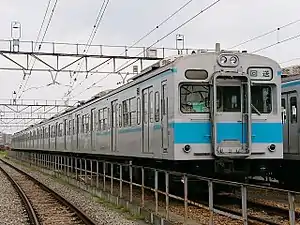 Revised livery with light blue stripe, May 2003 | |
| In service | 1971–2003 |
| Constructed | 1971–1978 |
| Entered service | 1971 |
| Scrapped | 2003-2004 |
| Number built | 35 vehicles (5 sets, initially 7-car trainsets) |
| Number in service | None |
| Number scrapped | 35 vehicles |
| Formation | 7/10 car per trainset |
| Operator(s) | JNR (1971-1987) JR East (1987-2003) |
| Line(s) served | Tokyo Metro Tozai Line, Chuo-Sobu Line |
| Specifications | |
| Multiple working | 301 series |
Similar to the 103-1000 series, these were 7-car sets built by Nippon Sharyo and Tokyu Car Corporation for use on Chūō-Sōbu Line-Tōzai Line inter-running services alongside the aluminium-bodied 301 series. 5 sets (35 cars) were built between 1970 and 1978. They were initially painted in grey with a yellow stripe, but this was changed to a light blue stripe from 1989 to avoid confusion with the similarly coloured 205 series trains introduced on Chūō-Sōbu Line services.[7] The last set was retired in July 2003.
 A JR East 301 series (left) and 103-1200 series (right) EMU formation at Funabashi Station, August 2002
A JR East 301 series (left) and 103-1200 series (right) EMU formation at Funabashi Station, August 2002
103-1500 series
| 103-1500 series | |
|---|---|
 Chikuhi Line 103-1500 series train running along the Nijino Matsubara pine trees, December 2019 | |
| In service | 1982–present |
| Replaced | KiHa 35, KiHa 58 |
| Constructed | 1982–1984 |
| Entered service | 1982 |
| Scrapped | 2015– |
| Number built | 54 vehicles (9 sets, initially 6-car trainsets, and later become 3-car trainsets) |
| Number in service | 15 vehicles (5 sets) |
| Number scrapped | 39 vehicles (13 sets) |
| Formation | 3/6 cars per trainset |
| Operator(s) | JNR (1982-1987) JR Kyushu (1987-Present) |
| Depot(s) | Karatsu |
| Line(s) served | Chikuhi Line, Kūkō Line |
| Specifications | |
| Car body construction | Steel |
| Car length | 20,000 mm (65 ft 7 in) |
| Width | 2,800 mm (9 ft 2 in) |
| Height | 3,935 mm (12 ft 10.9 in) |
| Doors | 4 pairs per side |
| Maximum speed | 100 km/h (62 mph) |
| Weight | 34.1 t (KuHa 103) 42.2 t (KuMoHa 102) |
| Traction system | Resistor control |
| Power output | 440 kW per car with motors |
| Acceleration | 2.5 km/h/s |
| Deceleration | 5.0 km/h/s |
| Electric system(s) | 1,500 V DC |
| Current collection method | overhead catenary |
| Track gauge | 1,067 mm (3 ft 6 in) |
Nine 103-1500 series 6-car sets were built between 1982 and 1983 by Kawasaki Heavy Industries and Hitachi for use on inter-running services between the Chikuhi Line and the Fukuoka City Subway Kūkō Line in Kyushu. In 1989, four sets were reformed as eight 3-car sets (numbered E11 to E18) by rebuilding MoHa 103 and MoHa 102 cars as KuMoHa 103 and KuMoHa 102 cars respectively. They were initially painted in light blue with a white stripe, but were repainted into a grey and red livery from 1995. The 3-car sets were modified for driver-only operation between December 1999 and March 2001.[8] Toilets were added to one end car of each set between June 2003 and October 2004.[9]
 103-1500 series in original livery, February 1983
103-1500 series in original livery, February 1983 JR Kyushu 103-1500 series in revised livery, April 2006
JR Kyushu 103-1500 series in revised livery, April 2006
103-3000 series
| 103-3000 series | |
|---|---|
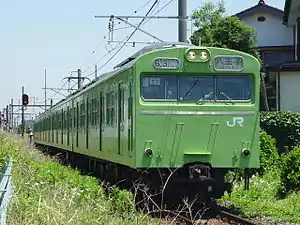 4-car Kawagoe Line set 53, June 2004 | |
| In service | 1985–2005 |
| Replaced | KiHa 35 |
| Constructed | 1972–1974 (remodeled 72-970 series) |
| Entered service | 1985 |
| Scrapped | 2004-2005 |
| Number built | 15 vehicles (5 sets, initially 3-cars per set) |
| Number in service | None |
| Number scrapped | 15 vehicles |
| Formation | 3/4 cars per trainset |
| Operator(s) | JNR (1985-1987) JR East (1987-2005) |
| Line(s) served | Kawagoe Line, Hachiko Line |
Five three-car 103-3000 series sets (numbered 51 to 55) were formed in 1985 from former 72-970 series EMU cars for use on the Kawagoe Line following electrification in September 1985. Five MoHa 72970 cars were also converted to SaHa 103-3000 cars to augment Ome Line trains. These cars were fitted with passenger-operated door controls. The five Kawagoe Line sets were lengthened to four cars between October 1995 and March 1996 ahead of Hachiko Line electrification in March 1996.[7][10] The last set was withdrawn in October 2005.
 Kawagoe Line 103-3000 series set 53 as a three-car set in May 1993
Kawagoe Line 103-3000 series set 53 as a three-car set in May 1993
- Formation
- KuMoHa 102-3000
- MoHa 103-3000 (with pantograph)
- SaHa 103-3000
- KuHa 103-3000
103-3500 series (JR East)
| 103-3500 series (JR East) | |
|---|---|
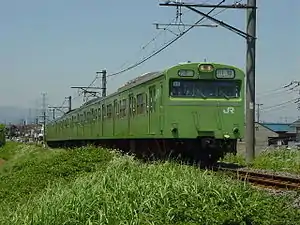 4-car Kawagoe Line set 56, June 2004 | |
| In service | 1996–2005 |
| Replaced | KiHa 35 |
| Constructed | 1967-1968 (remodeled 103-0 series) |
| Entered service | 1996 |
| Refurbished | 1995 |
| Scrapped | 2005 |
| Number built | 4 vehicles (1 set) |
| Number in service | None |
| Number scrapped | 4 vehicles (1 set) |
| Formation | 4 cars per trainset |
| Operator(s) | JR East (1996-2005) |
| Line(s) served | Kawagoe Line, Hachiko Line |
One 4-car 103-3500 series set was formed in December 1995 from surplus 103-0 series cars to augment the fleet ahead of Hachikō Line electrification in March 1996. As with the 103-3000 series sets, passenger-operated door controls were fitted. The motor/trailer car configuration differed from that of the 103-3000 series sets.[7][10] The set was withdrawn in March 2005.
- Formation
- KuHa 103-3502 (formerly KuHa 103-738)
- MoHa 102-3501 (formerly MoHa 102-2047)
- MoHa 103-3501 (with pantograph) (formerly MoHa 103-790)
- KuHa 103-3501 (formerly KuHa 103-725)
103-3500 series (JR West)
| 103-3500 series (JR West) | |
|---|---|
 JR-West refurbished 2-car 103-3500 series sets in Bantan Line livery, March 2009 | |
| In service | 1998–present |
| Entered service | 1998 |
| Refurbished | 1997–1998 |
| Number built | 18 vehicles (9 sets) |
| Number in service | 18 vehicles (9 sets) |
| Formation | 2 cars per trainset |
| Operator(s) | JR West (1998-present) |
| Line(s) served | Bantan Line |
Nine 2-car 103-3500 series refurbished sets (H1 to H9) were formed between September 1997 and March 1998 ahead of Bantan Line electrification in March 1998. Toilets were added between 2005 and 2006.[8][4]
- Formation
- KuMoHa 102-3500 (with toilet)
- KuMoHa 103-3500 (with pantograph)
103-3550 series
| 103-3550 series | |
|---|---|
 JR-West refurbished Kakogawa Line 2-car 103-3550 series set, January 2008 | |
| In service | 2005–present |
| Replaced | KiHa 37, KiHa 40, KiHa 47 |
| Entered service | 2005 |
| Refurbished | 2004 |
| Number built | 16 vehicles (8 sets) |
| Number in service | 16 vehicles (8 sets) |
| Formation | 2 cars per trainset |
| Operator(s) | JR West (2005-present) |
| Line(s) served | Kakogawa Line |
Eight 2-car 103-3550 series refurbished sets (M1 to M8) were formed between January and October 2004 ahead of Kakogawa Line electrification in March 2005. These sets feature cab gangway connections and toilets.[8][4]
- Formation
- KuMoHa 102-3550 (with toilet)
- KuMoHa 103-3550 (with pantograph)
 Kakogawa Line 2-car 103-3550 series set M1 with Train with eyes livery by Tadanori Yokoo, October 2005
Kakogawa Line 2-car 103-3550 series set M1 with Train with eyes livery by Tadanori Yokoo, October 2005 Kakogawa Line 2-car 103-3550 series set M2 with Travel in a galaxy livery by Tadanori Yokoo, February 2006
Kakogawa Line 2-car 103-3550 series set M2 with Travel in a galaxy livery by Tadanori Yokoo, February 2006 Kakogawa Line 2-car 103-3550 series set M8 with Run! Three-way junction livery side view by Tadanori Yokoo, August 2007
Kakogawa Line 2-car 103-3550 series set M8 with Run! Three-way junction livery side view by Tadanori Yokoo, August 2007
Internal training sets
One internal crew training set, formed as KuMoHa 103-100 + MoHa 102-224, was used for internal crew training at the JR East Crew Training Center at Higashi-Omiya Depot. The set had different cab end designs, as MoHa 102-224 used the cab of former ATC equipped KuHa 103-332, sets. It was withdrawn in 2009 following the delivery of a new 209 series-based training set in 2008.
 Higashi-Ōmiya set, 2008
Higashi-Ōmiya set, 2008
Preserved examples
- KuHa 103-1: Preserved at the Kyoto Railway Museum in Kyoto since April 2016.[11]
- KuHa 103-525: Stored at Toshiba factory in Fuchu, Tokyo[12]
- KuHa 103-713: Preserved at the Railway Museum in Saitama, Saitama (front end only).[13]
- KuMoHa 103-18: Stored at Mino-Ōta Depot in Minokamo, Gifu.[13]
- KuMoHa 103-58: Previously Used at the Toshiba factory in Fuchu, Tokyo. Scrapped in 2011.[14]
- KuMoHa 103-110: Used for training purposes at the Osaka Prefectural Firefighting College in Daito, Osaka.[13]
- KuMoHa 103-147: Privately preserved in Ibaraki Prefecture.[13]
 KuMoHa 103-18 at Mino-Ōta Depot in April 2007
KuMoHa 103-18 at Mino-Ōta Depot in April 2007 KuHa 103-525 at the Toshiba factory in Fuchu in March 2010
KuHa 103-525 at the Toshiba factory in Fuchu in March 2010 MoHa 102-230 stored at the RTRI facility in Kokubunji, Tokyo, in October 2010
MoHa 102-230 stored at the RTRI facility in Kokubunji, Tokyo, in October 2010
References
- Jr電車編成表 2018冬 JR電車編成表 2018冬 [JR EMU Formations - Winter 2018] (in Japanese). Japan: Kotsu Shimbunsha. 15 November 2017. p. 422. ISBN 978-4-330-84117-5.
- Haraguchi, Takayuki (2009). Jr全車両: ビジュアル決定版 Encyclopedia of JR's Railway Cars: JR全車両 (in Japanese). Japan: Sekai Bunka. p. 60–61. ISBN 978-4-418-09905-4.
- JR East news release (9 October 2009) Archived 13 July 2011 at the Wayback Machine. Retrieved 9 October 2009. (in Japanese)
- JR電車編成表 '07冬号 [JR EMU Formations - Winter 2007]. Japan: JRR. December 2006. ISBN 978-4-88283-046-7.
- インドネシアで活躍する日本の電車2009 [Japanese EMUs active in Indonesia 2009]. The Railway Pictorial. 59 (824): 102–107. October 2009.
- 103系DDM改造車営業運転開始
- JR全車輛ハンドブック1997 [JR Rolling Stock Handbook 1997]. Japan: Neko Publishing. 1997.
- JR全車両ハンドブック2006 [JR Rolling Stock Handbook 2006]. Japan: Neko Publishing. 2006.
- JR電車編成表 2009夏 [JR EMU Formations - Summer 2009]. Japan: JRR. June 2009. ISBN 978-4-330-06909-8.
- JR電車編成表 '02夏号 [JR EMU Formations - Summer 2002]. Japan: JRR. June 2002. ISBN 978-4-88283-037-5.
- 京都鉄道博物館 [Kyoto Railway Museum]. Japan Railfan Magazine (in Japanese). Vol. 56 no. 662. Japan: Koyusha Co., Ltd. June 2016. pp. 52–53.
- 3/23,東芝府中工場の103系とクモニ83が工場外に [23 March: Toshiba Fuchu Factory 103 series and KuMoNi 83 moved outside]. Japan Railfan Magazine. 52 (615): 178. July 2012.
- Sasada, Masahiro (25 November 2014). 国鉄&jr 保存車大全 2015-2016 国鉄&JR保存車大全2015-2016 [JNR & JR Preserved Rolling Stock Complete Guide 2015-2016] (in Japanese). Tokyo, Japan: Ikaros Publications Ltd. p. 123. ISBN 978-4863209282.
- Sasada, Masahiro (September 2012). 国鉄&jr保存車大全: 日本全国全カテゴリー1312両 国鉄&JR保存車大全 [JNR & JR Preserved Rolling Stock Complete Guide] (in Japanese). Tokyo, Japan: Ikaros Publications Ltd. p. 127. ISBN 978-4863206175.
Further reading
- Moro, Nobuaki (30 June 2012). 103系物語: 戦後日本の高度成長を支えた通勤電車 103系物語 [The 103 series story]. Japan: JTB Can Books. ISBN 978-4533086991.
External links
| Wikimedia Commons has media related to 103 series. |
- "JR East 103 series". jreast.co.jp (in Japanese). Archived from the original on 10 February 2010. Retrieved 19 March 2009.
- "JR Central train information page". jreast.co.jp (in Japanese). Archived from the original on 22 May 2010. Retrieved 16 March 2009.
